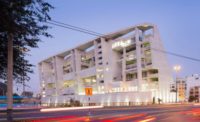Kazuyo Sejima and Ryue Nishizawa, partners of Tokyo-based Sejima and Nishizawa and Associates, better known as SANAA, will receive the 2010 Pritzker Prize. The firm’s buildings, characterized by their minimal material palette, spare details, and fluid spatial organization, were praised by the jury as places where “the physical presence retreats and forms a sensuous background for people, objects, activities, and landscapes.”
Established in 1979, the Pritzker is bestowed each year by the Hyatt Foundation to a living architect, or architects, who have consistently produced important work. This is the third time that two architects have received the award simultaneously. Jacques Herzog and Pierre de Meuron, firm partners, won in 2001, and in 1988, Oscar Niemeyer and SOM’s Gordon Bunshaft shared the honor. In its citation, the jury noted the collaborative nature of Sejima and Nishizawa’s work: “It is virtually impossible to untangle which individual is responsible for what aspect of a particular project.”
At 44 years old, Nishizawa is the youngest architect to ever win the Pritzker. (The honor previously was held by Richard Meier, who was 49 when he received the 1984 prize). Sejima, 54, is only the second female laureate, following Zaha Hadid’s win in 2004. “I am thrilled to receive such an honor,” Sejima said in a prepared statement. “I have been exploring how I can make architecture that feels open, which I feel is important for a new generation of architecture.”
Sejima, born in 1956, studied at the Japan Women’s University and, upon graduation in 1981, joined the Tokyo office of Toyo Ito. In 1987, she established her own firm, Kazuyo Sejima and Associates, which Nishizawa joined the same year. At the time, he was still a student at Yokohama National University, from which he graduated in 1990.
Nishizawa planned to leave the firm in 1995 to start his own practice. But Sejima convinced him to stay, making him a partner and renaming the office SANAA. Both Sejima and Nishizawa continue to also maintain separate practices, often focusing on smaller commissions.
Since its inception, SANAA has steadily expanded its portfolio of built work. Early commissions were mostly in Japan; the firm’s first major public project was the O-Museum (1999) in Nagano, Japan. The long, curving building, painted black and clad in fritted glass, is lifted up on columns on its wooded site. Though the firm’s later buildings employ a lighter material palette and are often located in urban settings, the O-Museum presaged SANAA’s distinguished career in museum architecture. Just five years later, in 2004, Sejima and Nishizawa finished what is widely considered their first masterpiece: the 21st Century Museum of Contemporary Art in Kanazawa, Japan. Located in the center of an urban park, the circular building opens on all sides to its surroundings. Discrete gallery spaces with varying floor areas and heights are set in a grid, creating a series of volumes that mirror the cityscape outside.
In recent years, the firm has completed a string of acclaimed international projects, including the 2006 Glass Pavilion at the Toledo Museum of Art in Ohio (its first U.S. project); the 2006 Zollverein School of Management in Essen, Germany; the 2007 Staadtstheatre Almere in the Netherlands; and the 2007 New Museum of Contemporary Art in New York City. This past February, the firm saw the grand opening of The Rolex Learning Center at the Ecole Polytechnique Federale de Lausanne, in Lausanne, Switzerland. The project signified a new exploration for the firm: The floor and ceiling of the single-story building have been conceived as an interior landscape, with hills and valleys demarcating different zones—libraries, cafés, meeting areas—that will be used by students.
In addition to their completed work, SANAA has several significant projects under way, including the Louvre Lens museum in Lens, France; an extension to the Institute d’Art Moderne in Valencia, Spain; and a factory building at the Vitra campus in Weil am Rhein, Germany. Sejima also was chosen to be the director of the Venice Biennale’s 2010 International Architecture Exhibition, which runs from August 29 to November 21. It won’t be her first involvement with the exhibition: Arata Isozaki invited her to participate in the Japanese pavilion in 2000, and in 2004, Sejima and Nishizawa’s museum in Kanazwa won the Biennale’s Golden Lion for “most remarkable work.” The duo also designed last year’s widely praised temporary pavilion at London’s Serpentine Gallery.
Sejima and Nishizawa have been a force in academia, as well. The two have taught and lectured at universities worldwide, including Keio University (Sejima), Yokohama National University (Nishizawa), and both at the Princeton School of Architecture. While neither has written a formal treatise on their work, their projects have been widely published in monographs by different publishers, including Japan Architect, El Croquis, and Electa Architecture, among others.
Sejima and Nishizawa are the fourth and fifth laureates from Japan, the others being Kenzo Tange (1987), Fumihiko Maki (1993), and Tadao Ando (1995). In regards to winning, Nishizawa said in a prepared statement that he feels “honored and at the same time very surprised.” He added: “I receive and understand this prize as encouragement for our efforts. Every time I finish a building I revel in possibilities and at the same time reflect on what has happened. Each project becomes my motivation for the next new project.”
Sejima and Nishizawa will be recognized at a formal ceremony on May 17 at Ellis Island in New York. The Pritzker includes a $100,000 cash prize and a bronze medallion.
Editor's note: Kazuyo Sejima is 54 years old, not 59, as the story originally stated.


